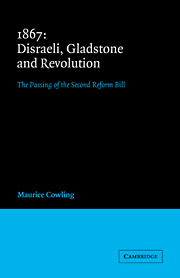Book contents
- Frontmatter
- Contents
- Preface
- Dedication
- Introduction
- I Prelude
- II Preliminary: The uprooting of the Whigs
- III The cornering of the Conservative party
- IV The reassertion of Conservative policy
- V The destruction of Liberal unity
- VI The victory of Disraeli
- VII The public agitation
- VIII The acceptance of Hodgkinson's amendment
- IX Conclusion: Palmerston's mantle
- Epilogue: The limitations of historical knowledge
- Appendixes
- Bibliography
- Notes
- Index
VIII - The acceptance of Hodgkinson's amendment
Published online by Cambridge University Press: 18 December 2009
- Frontmatter
- Contents
- Preface
- Dedication
- Introduction
- I Prelude
- II Preliminary: The uprooting of the Whigs
- III The cornering of the Conservative party
- IV The reassertion of Conservative policy
- V The destruction of Liberal unity
- VI The victory of Disraeli
- VII The public agitation
- VIII The acceptance of Hodgkinson's amendment
- IX Conclusion: Palmerston's mantle
- Epilogue: The limitations of historical knowledge
- Appendixes
- Bibliography
- Notes
- Index
Summary
‘I cannot but think that the opportunity [the 3rd reading of the Reform bill] would be a good one for making an appeal to the instinct and good sense of Englishmen, and, tho' it may be a repetition, to dispel the apprehension that the measure is a democratic one…The Ministry and the House of Commons have shown (Mr Gladstone and Mr Bright notwithstanding) that they trust the people of England.’
G. A. Hamilton, memorandum-to Derby dated July 141 867. Hughenden MSSBy May 2 Ayrton's motion had been passed with some Conservative support and a sizeable Conservative abstention in opposition to the government, which, though it had Adullamites voting with it, had no Radical support at all. It had been passed in circumstances in which, although the two-year residential qualification had been made an issue of confidence in the first week of April, it could not sensibly be made the occasion for a general election. As Taylor knew, and the division lists made clear, it was not even a restriction which all Conservatives felt happy to maintain. It was impossible in his view to resign on it, and it is clear that resignation did not appeal to Disraeli. On the other hand, though the immediate problem was solved by the Cabinet's decision to accept the amendment despite Hardy's objections, it seemed likely that there would be similar problems in the future. Disraeli's willingness to concede was inexhaustible, but, if the situation recurred in which he had to concede after resisting and being defeated in the House, confidence in the government's control of the situation would vanish. This would have been true at any time.
- Type
- Chapter
- Information
- 1867 Disraeli, Gladstone and RevolutionThe Passing of the Second Reform Bill, pp. 267 - 286Publisher: Cambridge University PressPrint publication year: 1967
- 2
- Cited by

